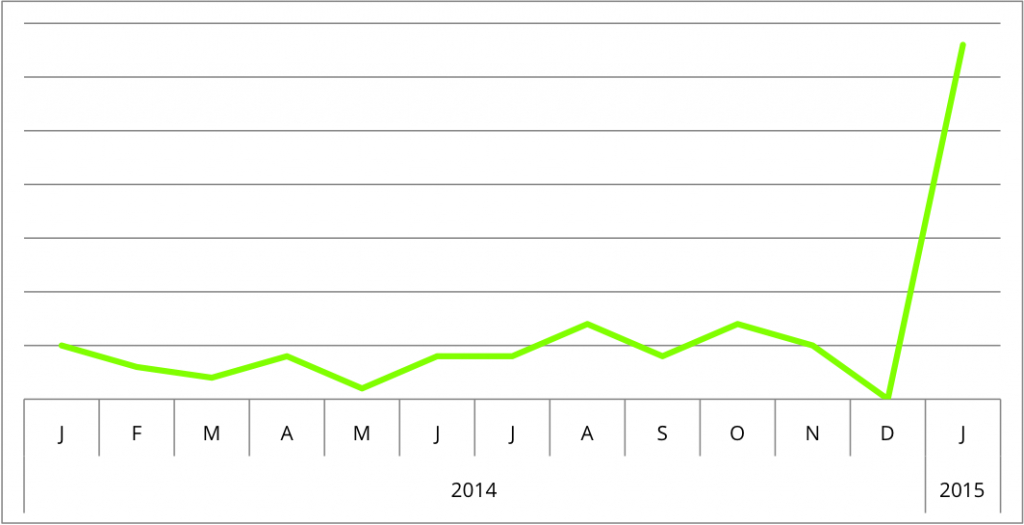When Jelly Belly factories are churning out 50 tons of jelly beans per day (that’s approximately the weight of eight African elephants!), there’s bound to be a few mistakes. And with 347 Jelly Bellys produced each second, misshapen and discolored beans can accrue quite quickly.

From Very Cherry and Buttered Popcorn to Booger and (I kid you not) Vomit, Jelly Belly flavors run the gamut. These ones, at least, look delicious! [Image: Stefan Schausberger, CC BY 2.0]
Like any mass production line, stringent “quality control” checks for any defective beans, including those that are lumpy and deformed, or ones that somehow evaded their logo-stamping machine. These less-than-flawless candies are separated from their adequately formed peers, then (in a stroke of marketing genius) branded and resold as Belly Flops.

So smart! These cuties are re-branded as Belly Flops, and sold at half-price. [Image: Mike Mozart, CC BY 2.0]
But not everything that fails quality control can be reused. Mislocalized proteins, for instance, can be quite dangerous. Having hydrophobic regions, transmembrane proteins that fail to reach the membrane can accumulate in the cytosol, aggregating with other transmembrane proteins and forming clumps. Quality control systems also detect misfolded proteins, which are subsequently dumped into the cytosol. These too are a threat, especially if they aggregate. (Need a reminder? Think about the poster child for protein disasters, prions. Misfolded protein aggregates are bad.) Even proteins that were unlucky enough not to have found their necessary binding partners (Do we need a Tinder for proteins?) get tossed out to the cytosol, where they await degradation.1

You don’t need an Instagram filter to see that these Belly Flops are still delicious! It’s too bad that defective proteins aren’t this cute, but lucky that our cells have a system to find and destroy them before they do damage. [Michael Roper, CC BY-SA 2.0]
This is where BAG6 enters the scene. Known by the unwieldy “BCL-associated anthanogene 6” (and also as Bat-3 or Scythe), this protein has more functions than it even has names. But one of its most interesting roles is as a master regulator for protein quality control: sorting proteins for use, or (if they fail to meet standards) degradation.2
As a critical component of several cellular systems, BAG6 is a highly conserved protein.3 In fact, it is essential to life; genetic ablation of BAG6 (in mice models) causes neonatal lethality, due to developmental defects in apoptosis and cell proliferation.4 However, while BAG6 was initially studied for its role as a cell death regulator, research focus today has shifted towards its other functions. Found primarily in the cytosol, BAG6 recognizes and interacts with the hydrophobic domains of transmembrane proteins.5 Once BAG6 binds to a mislocalized target protein, RNF126 (a ubiquitin ligase) is able to mark the defective protein for degradation via the ubiquitin-proteasome system.6
While the presence of hydrophobic domains in the cytosol is a hallmark for mislocalized proteins, it’s also characteristic of newly synthesized transmembrane proteins that haven’t yet been transported to the membrane. BAG6 not only marks mislocalized proteins for ubiquitination (and thus degradation),7 but also chaperones these newly synthesized proteins.8 Transmembrane proteins must be constantly chaperoned in the cytosol, as their hydrophobic domains can cause inappropriate interactions or aggregations. BAG6 does so, by binding to their hydrophobic domains, protecting them from the cytosolic environment, and shuttling them to the correct place for membrane insertion.9
How BAG6 makes this sorting decision, how it recognizes which proteins should be transported or degraded, is still unknown. Regardless, mislocalized and misfolded proteins can be extremely dangerous (certainly more so than misshapen jelly beans!), so BAG6’s role in quality control might be mysterious, but is no less vital. As many neurodegenerative diseases can attest (like ALS, Alzheimer’s, Parkinson’s, Huntington’s, and prion diseases) inappropriate protein accumulation and subsequent aggregation can be incredibly damaging and even toxic. Maintaining cellular homeostasis and cleaning up after aberrant proteins may not be a glamorous job, but it certainly is a critical one.

BAG6 might have first been discovered for its role in apoptosis, but lately, studies have focused on its function as a regulator of protein quality control. The most recent paper, just out last month, elucidates the structure of the BAG6 complex. Other research has also pointed to another role for BAG6: As a ligand for NKp30, a receptor of human natural killer cells, there is some hope for BAG6-mediated tumor immunotherapies.10 Development of such therapies is however, still at a speculative stage.
REFERENCE:
- Claessen JH, Sanyal S, Ploegh HL. (2014) The chaperone BAG6 captures dislocated glycoproteins in the cytosol. PLoS One 9(3):e90204. [↩]
- Lee JG, Ye Y. (2013) Bag6/Bat3/Scythe: a novel chaperone activity with diverse regulatory functions in protein biogenesis and degradation. Bioessays 35(4):377-85. [↩]
- Lee JG, Ye Y. (2013) Bag6/Bat3/Scythe: a novel chaperone activity with diverse regulatory functions in protein biogenesis and degradation. Bioessays 35(4):377-85. [↩]
- Binici J, Koch J. (2014) BAG-6, a jack of all trades in health and disease. Cell Mol Life Sci 71(10):1829-37. [↩]
- Lee JG, Ye Y. (2013) Bag6/Bat3/Scythe: a novel chaperone activity with diverse regulatory functions in protein biogenesis and degradation. Bioessays 35(4):377-85. [↩]
- Rodrigo-Brenni MC, Gutierrez E, Hegde RS. (2014) Cytosolic quality control of mislocalized proteins requires RNF126 recruitment to Bag6. Mol Cell 55(2):227-37. [↩]
- David R. (2011) BAG6 ‘mops up’ mislocalized proteins. Nat Rev Mol Cell Biol 12(9):550. [↩]
- Binici J, Koch J. (2014) BAG-6, a jack of all trades in health and disease. Cell Mol Life Sci 71(10):1829-37. [↩]
- Lee JG, Ye Y. (2013) Bag6/Bat3/Scythe: a novel chaperone activity with diverse regulatory functions in protein biogenesis and degradation. Bioessays 35(4):377-85. [↩]
- Binici J, Hartmann J, Herrmann J, Schreiber C, Beyer S, Güler G, Vogel V, Tumulka F, Abele R, Mäntele W, Koch J. (2013) A soluble fragment of the tumor antigen BCL2-associated athanogene 6 (BAG-6) is essential and sufficient for inhibition of NKp30 receptor-dependent cytotoxicity of natural killer cells. J Biol Chem 288(48):34295-303. [↩]

Trackbacks/Pingbacks